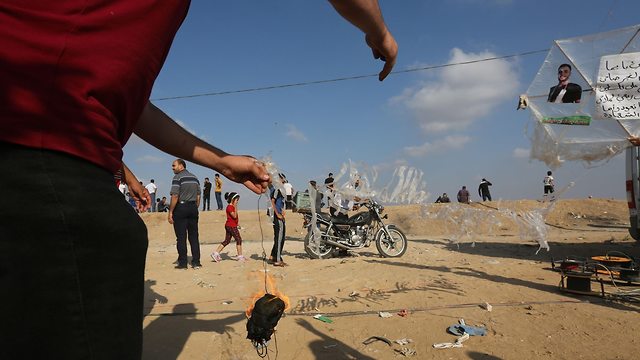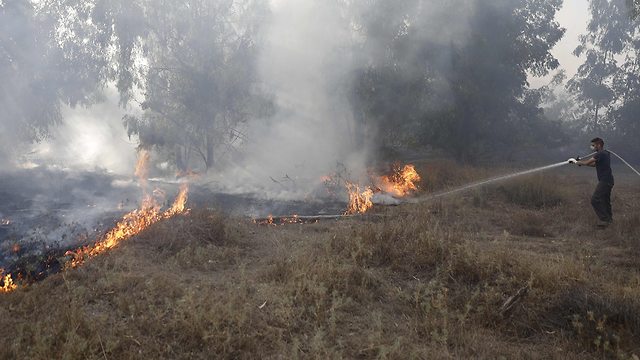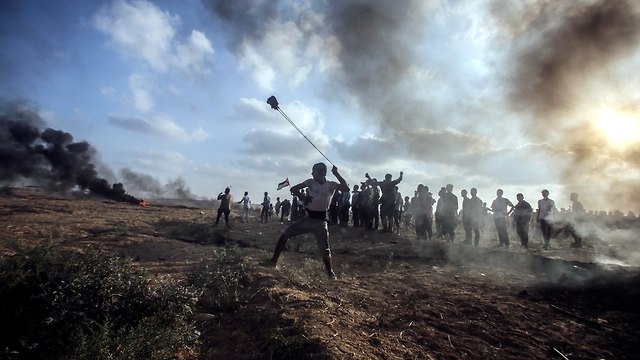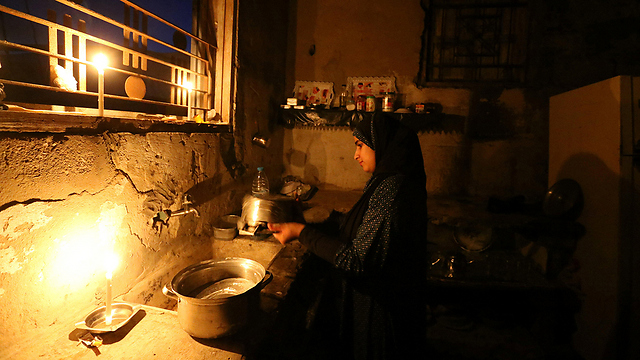

How the incendiary balloons and kites could lead to war
Analysis: Neither Israel nor Hamas want another round of fighting in Gaza, so why have chances of a war breaking out increased? Hamas mistakenly believes the incendiary balloons give it a psychological victory over Israel's citizens. Israel must make the terror group realize such measures are of no use to it.
Both Hamas and the IDF are not interested in an escalation that would lead to another major war in Gaza. Both sides have a clear interest not to embark on another round of casualties and killing in the Gaza Strip. Hamas knows that it will be beaten militarily and may even lose control of the Gaza Strip as a result of another round of fighting. Israel knows another war in the strip—even though the IDF is more prepared for it than ever before—will be a Pyrrhic victory. In other words, a war in which even the victor loses.
Israel may have to—as a result of another round of fighting in Gaza—not only conquer the Gaza Strip, but also remain there after the Hamas regime collapses and shoulder the security and economic burden that entails. It therefore begs the question: If Hamas and Israel want to prevent a war so much, why does Israel's national intelligence assessment say that the chances of war in the south have recently increased exponentially?
The reason for this may be the incendiary balloons terrorism; more precisely, the conclusion Hamas has reached that the incendiary kite and balloon terrorism has had such an enormous psychological impact on Israelis that it could empty the western Negev of most of its inhabitants. No less.
Every Israeli, whether he is a resident of the south or not, knows that this is absolute nonsense; that no Israeli citizen would leave his home in the Gaza border area or in the Negev in general because of the fires caused by the incendiary balloons.
Still, verified information about Hamas's intentions and plans gathered by Israeli intelligence indicates that the terror group—based on its officials' comments in the media, public discourse and political discourse in Israel—has concluded that the incendiary balloon terrorism is likely to achieve what bombings, shootings, rockets and mortar shells failed to achieve. In Gaza, the Islamists believe that the incendiary balloons and kites are the "silver bullet" that will cause the Israeli residents of the south to surrender.
As absurd as that sounds, this is the thinking in Gaza—and therefore Hamas not only invests money in the incendiary balloon cells, placing some of its men at the helm—but it is part of its plan.
The absurdity is especially evident in light of the fact that the damage being caused by the incendiary balloons and kites is diminishing, and in recent weeks there has been a steady decline in the size of the area consumed by the fires they cause. This has been achieved thanks to the measures the IDF has been taking to reduce the number of incendiary kites that cross the border almost to none. Among these measures are drones that cut the kite's strings and intercept them, and the many companies the IDF has deployed to the Gaza border to spot the kites and quickly put out the fires. Five such companies have helped make the area consumed by fire much smaller than originally thought: "only" 20,000 dunams (5,000 acres). Two-thirds less than what the IDF had estimated so far.
And so, the area destroyed by the blazes is diminishing, and the main problem at the moment is the incendiary balloons, which are flown from deeper inside the Gaza Strip. These balloons can fly at a height of more than a kilometer, and then they are hard to spot with the naked eye before they land and light the fire. The IDF is already in the process of developing advanced measures that will eventually help resolve this problem—just as they managed to overcome the incendiary kites.
But what encourages Hamas is the psychological success: it succeeds in presenting to the world a misrepresentation in which the subjugated and oppressed residents of Gaza are trying to break the Israeli siege with the symbolic step of burning fields in Israeli communities near the border. "Samson's Foxes," the Hamas version—just the opposite.
But what really causes Hamas to continue with the organized and deliberate incendiary balloon terrorism is its conclusion that it could, with psychological warfare, achieve what it has not achieved so far with fighting and terrorism. This can be said to be the first battlefield in which the IDF encounters clear psychological warfare that has no military aspect. Military historians will undoubtedly write mountains of research and commentary about it. But the IDF must find a real solution for the balloon terrorism now.
IDF might have no choice but to target balloon fliers
The IDF's dilemma is clear: The response to the incendiary balloons nuisance must be proportionate, since the media and the international community will not accept with understanding nor consider as self-defense the killing of children who fly kites and balloons because of some fires in fields near the Gaza Strip. It's also immoral.
By the way, Hamas has also stopped sending children to the fence and to the incendiary kite and balloon cells because of public criticism inside Gaza; but since there are quite a few youths aged 15-16 in those cells—who are members of Hamas—the IDF believes that the day will soon come when the State of Israel will have to approve strikes against these youths—physical injury that may even lead to their deaths.
"We are not there yet," a source told me. "But if the fields and the natural assets continue to go up in flames, there may be no choice."
Another sanction that the State of Israel and the IDF impose in order to stop the incendiary kite and balloon terrorism is the restrictions on the delivery of building materials and other goods to the Gaza Strip—with the exception of food and medicine. There are also restrictions on fishing zones off the Gaza coast, and the IDF has a rather long list of additional economic sanctions that will cause more and more anger among the Gaza populace against the Hamas regime. This, of course, is in addition to the military assets Hamas is losing as a result of Israeli strikes.
But along with the offensive measures, Israel has made Hamas—through Egyptian mediators and UN envoy Nickolay Mladenov—quite the tempting offer: immediate economic benefits, such as improving the water quality in the Gaza Strip and dramatically increasing the amount of electricity the strip receives. These could both be done within days, and they could dramatically improve the lives of Gazans.
Israel is ready to give Hamas the immediate economic incentives in exchange for a complete halt of the incendiary kite and balloon terrorism. Israel, the IDF says, has a clear interest in improving the humanitarian situation of Gaza residents and alleviating their suffering, but as long as the incendiary kite and balloon terrorism continues, the political echelon doesn't want nor can it approve easing these restrictions.
In the longer term, Israel is willing to take part in the rehabilitation and development of the Gaza Strip in order to significantly improve the living conditions of its inhabitants. But this is contingent not only on the halt of terrorism coming out of the Gaza Strip, but also on the return of Israel's POWs and MIAs in the Gaza Strip. Until this issue is resolved, Israel has already informed all of the relevant parties that it will not agree to any long-term action that would extricate the Gazans from their suffering.
Israeli officials say that if Hamas finally shows good faith in stopping the incendiary balloon terrorism and reaching an agreement on the return of the POWs and MIAs, Israel may ask US President Trump to transfer the aid money he cut from UNRWA's budget. But for now, the problem remains.
"As soon as Hamas understands that we are not really worried about the incendiary kites and balloons, and that the damage they causes is not as immense as they mistakenly think, then they will just abandon that measure, just as they have recently abandoned the idea of infiltrating the western Negev through underground tunnels," a senior defense official explained.
"They have recently realized that they are losing the advantage this measure gave them, and when they realize that the Israeli public is immune to the kind of psychological warfare they are waging, they will stop it."




















